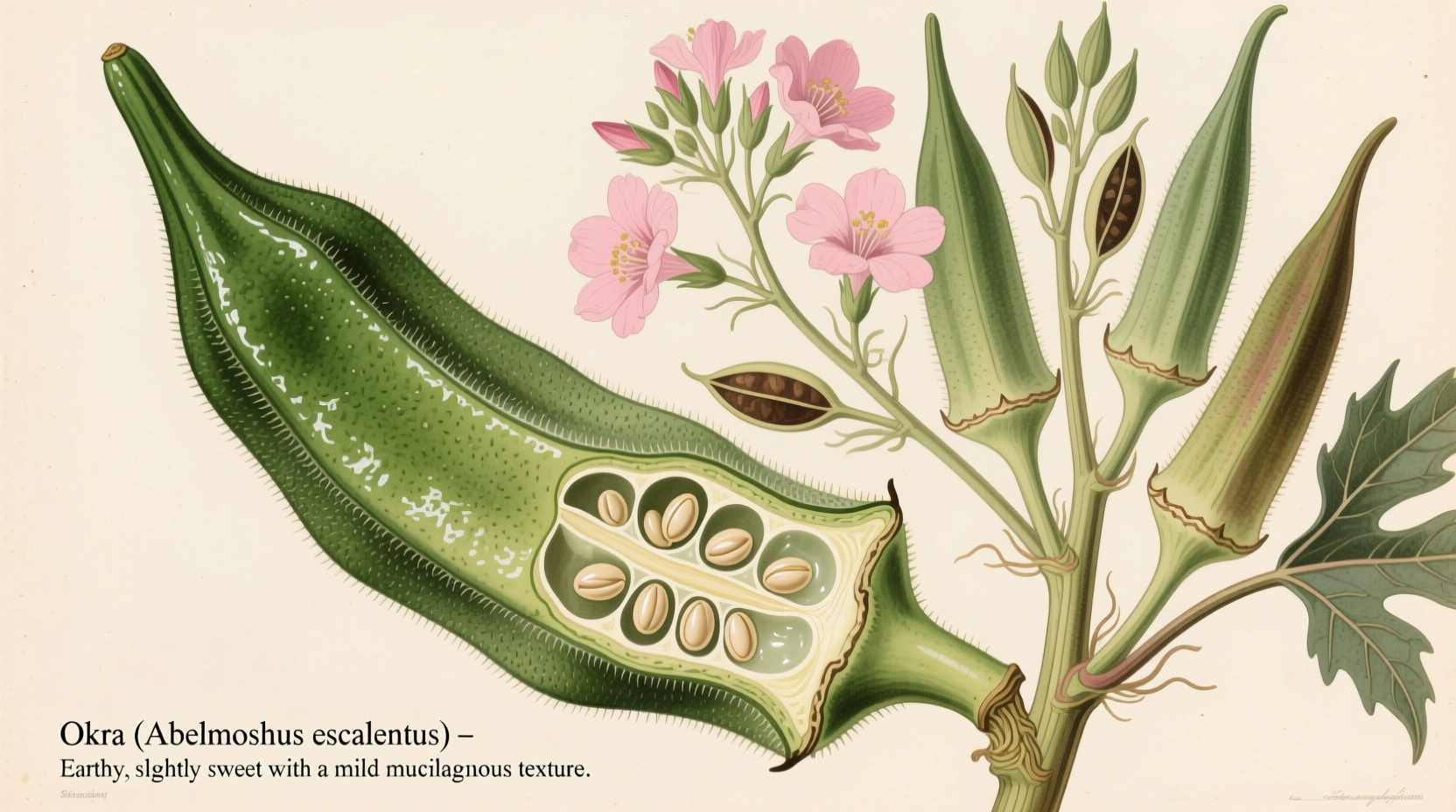Ever wonder what that odd green pod in your gumbo or stew actually is? You're not alone. Okra remains one of the most misunderstood vegetables in modern cooking, often avoided because of its reputation for sliminess. But understanding what okra is and what it actually tastes like can transform your cooking experience and expand your culinary horizons.
What Exactly Is Okra?
Botanically classified as Abelmoschus esculentus, okra belongs to the mallow family, which includes hibiscus and cotton. This flowering plant produces edible green seed pods that have been cultivated for thousands of years. Native to northeastern Africa, okra spread through trade routes to the Middle East, India, the Caribbean, and the American South, becoming a staple ingredient in many global cuisines.
Okra's Journey Through Time
Understanding okra's historical context helps explain its global culinary significance. Archaeological evidence from Egypt shows okra was cultivated as early as the 12th century BCE. By the 7th century CE, it had reached India, and Portuguese traders introduced it to the Americas in the 16th century. The word "okra" itself comes from the Igbo language of West Africa ("ọ́kụ̀rụ̀"), while the French called it "gombo," which evolved into "gumbo" in Louisiana cuisine.
Physical Characteristics You Should Know
Okra pods typically range from 2-10 inches long with a ridged, tapered shape. They come in various colors including:
- Standard green (most common in Western markets)
- Red varieties (turn green when cooked)
- Rare white or purple cultivars
Fresh okra should feel firm and crisp, with no dark spots or soft areas. The smaller pods (under 4 inches) tend to be more tender with less mucilage, making them ideal for raw preparations.
Demystifying Okra's Flavor Profile
The taste of okra depends significantly on preparation method and freshness:
| Preparation Method | Taste Characteristics | Texture Experience |
|---|---|---|
| Raw (young pods) | Crisp, grassy with subtle citrus notes | Firm, slightly crunchy with moderate mucilage |
| Quickly sautéed | Earthy, vegetal with nutty undertones | Tender-crisp with reduced sliminess |
| Slow-cooked in stews | Rich, absorbs surrounding flavors while adding body | Velvety, thickens liquid components |
| Fried (as in Southern style) | Crispy exterior with mild, sweet interior | Crunchy outside, tender inside with minimal slime |
The Truth About Okra's Mucilage (Slime Factor)
That slimy texture many fear is actually water-soluble fiber called mucilage, which has health benefits but can be managed. When okra is cut, its cells release this viscous substance that thickens when heated. Contrary to popular belief, the slime isn't inherently bad—it's what gives gumbo its distinctive texture. To minimize mucilage:
- Cook at high heat for shorter periods
- Add acidic ingredients like tomatoes or vinegar
- Try the "cap method"—leave stems intact when cooking
- Soak in vinegar water before cooking
Interestingly, many West African and Indian cuisines intentionally maximize this thickening property for soups and stews.
Global Culinary Applications
Okra's flavor adaptability explains its presence in diverse cuisines:
- American South: Essential for gumbo, often fried with cornmeal
- West Africa: Base for soups like Nigerian okra soup with palm oil
- India: Used in bhindi masala with spices like turmeric and cumin
- Caribbean: Featured in callaloo and seafood stews
- Middle East: Prepared with tomatoes and lemon in bamya
The vegetable's ability to absorb surrounding flavors while contributing its own subtle earthiness makes it remarkably versatile across culinary traditions.
Nutritional Benefits Worth Noting
Beyond taste, okra offers impressive nutritional value per 100g (USDA data):
- High in vitamin C (21% of daily value)
- Excellent source of vitamin K (26% DV)
- Rich in folate (15% DV)
- Good fiber content (3.2g)
- Contains antioxidants like quercetin
These nutrients contribute to okra's traditional use in folk medicine for digestive health and blood sugar regulation, though more research is needed on therapeutic applications.
Practical Tips for First-Time Okra Eaters
If you're new to okra, start with these approachable preparations:
- Roasted okra: Toss small pods with olive oil, salt, and paprika; roast at 425°F for 20 minutes until crisp
- Quick stir-fry: Slice and sauté with garlic and tomatoes for 5-7 minutes
- Raw in salads: Use young pods sliced thin with lemon vinaigrette
- Fried option: Dip in buttermilk, coat with cornmeal, and air-fry for 12 minutes
When selecting okra, choose firm, bright green pods under 4 inches long. Store unwashed in the refrigerator for up to 3 days, or freeze for longer storage after blanching.
Common Misconceptions About Okra's Taste
Many avoid okra based on misinformation:
- Myth: All okra is slimy regardless of preparation Truth: Proper cooking techniques significantly reduce mucilage
- Myth: Okra has a strong, overpowering flavor Truth: It has a mild, adaptable taste that complements other ingredients
- Myth: Only Southern US cuisine uses okra Truth: It's fundamental to West African, Indian, and Caribbean cooking traditions
Understanding these realities helps cooks appreciate okra's true culinary potential rather than fearing its misunderstood qualities.











 浙公网安备
33010002000092号
浙公网安备
33010002000092号 浙B2-20120091-4
浙B2-20120091-4